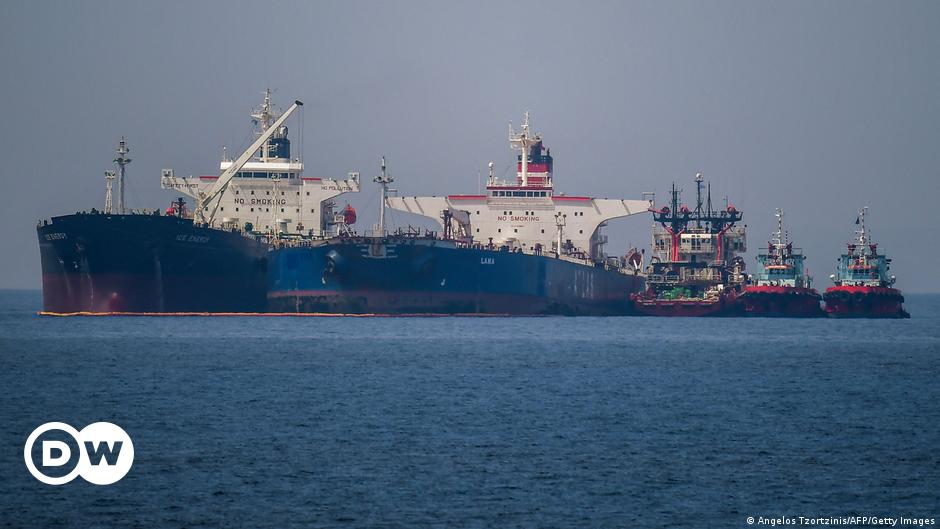Russia’s rupee problem risks harming trade ties with India – DW – 05/15/2023
India has emerged as a major buyer of Russian oil over the past year, after Moscow’s invasion of Ukraine triggered Western sanctions, forcing Russia to offer its crude at discounted rates.
The South Asian nation imported more oil from Russia than ever before in April, according to data from Vortexa, a ship tracking company.
In fact, Moscow became the top supplier of crude oil to India last month, with Russian supplies greater than those from Iraq and Saudi Arabia combined.
Before the war in Ukraine began in February last year, India bought very little oil from Russia.
But as sanctions cut off major Russian banks from much of the West’s payment systems, finding ways to pay for the Russian crude has become a challenge.
Over the past year, Indian importers have been paying for Russian oil and other commodities mostly in Indian rupees.
But currency restrictions mean Russian entities face difficulty in repatriating rupees.
How big is the problem?
The snapping up of discounted Russian crude, meanwhile, has widened India’s already substantial trade deficit with Russia.
In the first 11 months of the 2022-23 financial year, Indian imports from Russia were worth nearly $41.5 billion (€38 billion), while exports amounted to just $2.8 billion, according to data from the Ministry of Commerce and Industry.
This has left Russian oil companies and banks with billions of rupees in their Indian bank accounts — a pile of cash they are struggling to use.
“I don’t think this situation can continue for long,” Nandan Unnikrishnan, distinguished fellow and Russia expert at the Observer Research Foundation (ORF) in New Delhi, told DW. “If both sides fail to resolve the problem, it will impact purchases of not only oil but everything.”
Russian Foreign Minister Sergei Lavrov also recently commented on the issue while attending a Shanghai Cooperation Organization meeting in the Indian state of Goa.
“We need to use this money. But for this, these rupees must be transferred in another currency, and this is being discussed now,” he was quoted by news agency Bloomberg as saying.

Close ties between India and Russia
The uncertainties over payment mechanisms have also hurt defense imports, Bloomberg reported. New Delhi and Moscow share longstanding political and security ties.
India is a major buyer of Russian weapons, although it has been attempting to diversify its sources of military equipment, increasingly turning to countries like the US and France in recent years.
Russia accounted for $8.5 billion of the $18.3 billion New Delhi has spent on weapons imports since 2017, according to data from the Stockholm International Peace Research Institute.
Both sides are also in talks to reach a free trade agreement.
The Indian government has so far refrained from explicitly criticizing Russia’s war in Ukraine. New Delhi has abstained several times from voting on UN resolutions against Moscow. It has, however, called for a peaceful resolution of the conflict through dialogue.
The ramping up of trade ties, meanwhile, has been viewed with concern in Western capitals, as they fear it’s undermining the stringent sanctions regime in place against Moscow.
How can the two sides resolve the problem?
Besides the Indian rupee, the UAE dirhams and the Chinese yuan are seen by some as potential options to settle trade between India and Russia.
“Russia wants a currency that it can use to buy goods that it requires for its economy… the question is identifying that currency,” said Unnikrishnan. “Russians would be happy to use the yuan,” he underlined, pointing to their bilateral trade worth hundreds of billions of dollars.
In 2022, Russia-China commerce hit a record high of $190 billion.
But Unnikrishnan noted that New Delhi would not be comfortable allowing trade settlement in the yuan, given the tense relations between India and China due to their border disputes.
The Reuters news agency also reported in March, citing Indian officials, that the Indian government had asked banks and businesses to avoid using the yuan to pay for Russian imports.
Another option is the use of UAE dirhams to pay for India’s Russian imports but experts say this might not offer a viable long-term solution, due to the sensitivity of that currency to Western sanctions.
Unnikrishnan stressed that India and Russia could come up with alternative solutions, like productively investing the rupees into joint ventures that produce goods that are of use to Russia or could be exported to other parts of the world.
“There are multiple ways to deploy this money, and both sides just have to show the political will to reach that agreement,” Unnikrishnan said.
Edited by: Uwe Hessler
For all the latest business News Click Here

